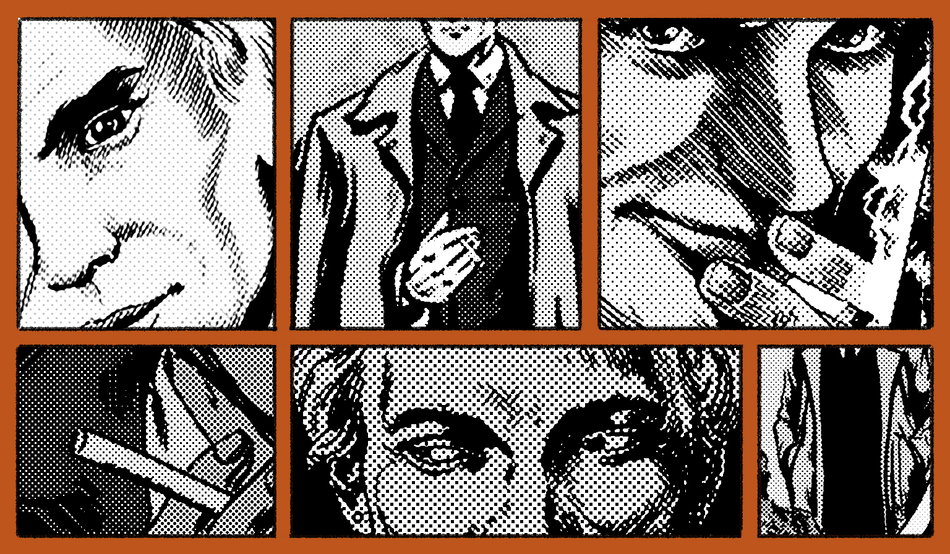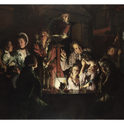Everyone knows John Constantine, or at least they think they do.
Journalist Satchmo Hawkins, in his celebrated Faces on the Street column that appeared in 1980s style magazine XS, declared: “The man is a legend, for chrissakes.”
Writer Alan Moore once claimed to have seen him in a sandwich bar in Westminster: “He looked at me, stared me straight in the eyes, smiled, nodded almost conspiratorially, and then just walked off.”
Hollywood megastar Keanu Reeves called him “hard-edged, hard-boiled, world-weary, cynical, fatalistic, nihilistic, self-interested”.
And former taxi driver Jamie Delano, recalling the start of his involvement with Constantine in 1988, observes with a curious mixture of fondness and bitterness: “The bastard has haunted me ever since.”
Most of that is somewhat true. But who, exactly, is John Constantine? The answer is that he’s the most important British character to ever appear in American comic books, where he’s variously an occult detective, a magician, a conman, a demon hunter, a loser, a saviour, a criminal, a hero, a villain, a lover and a fighter. He made the leap to the movies 20 years ago in a portrayal, by Reeves, that bemused some fans of the source material, and then, almost a decade later, to TV, played by Welsh actor Matt Ryan, a little closer to the comics.
Constantine—if you’re British, you’ll pronounce it correctly as Constan-Tyne; if American Constan-Teen—first appeared in issue 37 of the Swamp Thing comic published by DC, home of brightly coloured heroes Superman, Batman and Wonder Woman, 40 years ago.
A little over a year previously, Swamp Thing was a failing horror comic about a scientist who had been transformed into a huge, shambling, plant-based monster. Sales were low and DC was on the verge of cancelling the monthly title altogether, when they brought in a British writer who was unknown in the US but had been making waves in the UK’s much smaller comics industry, on titles such as Warrior and 2000AD.
The writer was Alan Moore, a hirsute writer from Northampton who was given free rein to do what he liked with Swamp Thing. What he did was create the sort of stories that hadn’t really been seen in American superhero comics before, and—as sales zoomed upwards—Moore’s employment opened the gates for what is known as the British Invasion.
Alan Moore wrote stories that hadn’t really been seen in American superhero comics before
Just like when America took the Beatles, the Stones, the Kinks, the Who and other British bands to their hearts two decades earlier, US publishers suddenly couldn’t get enough of British comics writers. Moore, at the vanguard, went on to create complex, adult-orientated comics such as Watchmen and the controversial Batman-Joker story The Killing Joke—but, in the meantime, while still writing Swamp Thing, he created John Constantine.
Moore’s artistic collaborators on that issue, Rick Veitch and John Totleben, visualised Constantine’s introduction in a nightclub scene, where he wears a mac thrown over a blue double-breasted suit, his blond hair swept back, looking just like his real-life model: Sting of the Police. And he was like Sting in another way, too: he was—is—British, and a far cry from the stereotyped, “cor, blimey” Cockneys whom American writers churned out at the time.
This Constantine has a mission: all the occult signifiers point to an apocalyptic event a year down the road, and Swamp Thing is the only being who has a chance of thwarting it. But the monster isn’t ready, so Constantine sends him on a journey into the dark, supernatural underbelly of the US—in a storyline called “American Gothic”—to prepare him for the trials ahead.
Like the rest of us, Constantine has a dog in the fight—he doesn’t particularly want to see the world end—so he doesn’t waste any time appealing to Swamp Thing’s sense of justice and righteousness. He simply threatens to publicly expose him and his human lover, Abby Arcane, setting out his stall with a smirk and the words: “I’m a nasty piece of work, chief. Ask anybody.”
The audience response on both sides of the Atlantic to Constantine’s character was so good that DC decided to give him his own monthly title. It was originally to be called Hellraiser, but the film adaptation with the same name of Clive Barker’s horror novella The Hellbound Heart was released in 1987, so by the time John Constantine embarked on his solo flight in January 1988 it was under the title Hellblazer.
The British Invasion of comics was well underway, and DC approached Delano, who had written for 2000AD and comics published by Marvel’s UK arm—and had indeed spent seven years as a taxi driver in Northampton before his comics career beckoned.
Delano says, “I had no idea that a Hellblazer series was in the offing until a phone call from [DC editor] Karen Berger invited me—I’m pretty sure on Alan’s recommendation—to submit a proposal for a first run of stories.
“The character was intrinsically British; so was I. The fit seemed good to Karen and publisher Jenette Kahn, I guess, and, to my surprise, I got the job. I honestly didn’t expect I’d string it out for more than 12 months... shows what I knew. The bastard has haunted me since.”
Delano, with artist John Ridgeway, took Moore’s creation and ran with him, adding depth, backstory and a wobbly moral compass. We learned that Constantine grew up in a working-class household in Liverpool, and that being his friend usually meant ending up dead, mad or broken. Constantine was no hero, unless you count the times when saving his own skin involved saving the world into the bargain. Constantine didn’t fight for truth and justice, nor was he driven by revenge or redemption. You got the feeling that he’d really rather not be involved in all the situations he found himself in, but there was just nobody else to deal with this sort of stuff.
Delano wrote more than three years of monthly issues of Hellblazer, and then the scripting baton was passed to several other writers, including The Boys creator Garth Ennis, Grant Morrison, Warren Ellis and Eddie Campbell.
Crime writer Denise Mina was the only female writer of Hellblazer during its initial 300-issue run, and says that for her time on the book she “wanted to bring him to Glasgow—traditionally the most sinister UK city. I thought he’d fit in here.”
Before getting the Hellblazer gig, Mina says she was pretty familiar with the character, citing her favourite stories as “Dangerous Habits”, written by Ennis, in which the chain-smoking Constantine contracts lung cancer and “All His Engines”, written by Mike Carey and with art by Leonardo Manco, who also drew Mina’s stories. “For me,” she says, “John Constantine was an anarchist punk noir detective. I wanted to recreate the character I’d loved in those two runs, but you never escape your own voice. I had a blast doing it.”
Fellow Scot, and bestselling Rebus author, Ian Rankin also wrote a standalone graphic novel featuring Constantine in 2009, Dark Entries, about a Big Brother-style gameshow where the contestants slowly realise they are dead and trapped in Hell. “I’ve been a Constantine fan since day one,” says Rankin, who first encountered Constantine in the Swamp Thing comics. “I like my comics characters to be human, and he fits the bill. He’s a maverick, a disruptor, a survivor, and he brought proper terror and horror back into comics.
“These were not stories for young kids or the faint-hearted. I loved that: proper grown-up storytelling that could scare your socks off but also make you laugh and cheer and care.
“His longevity is testament to his strengths as a character—he’s someone writers love to write for because we’d all like to be him or to know him. A complex, impish one-off. A sometimes unwilling hero.”
Hellblazer is ostensibly a horror comic, but, like all the best horror, it’s really about the world around us—and has never been afraid to tackle political and social themes head on. In an early Delano issue, Constantine comes up against a group of Thatcherite yuppies who are literally demons in service of the god of material wealth, Mammon. He ends the issue hanging upside down and forced to watch the Conservative landslide victory in the 1987 general election live on TV. More recently, in their 2024 series “Dead in America”, writer Simon Spurrier and artist Aaron Campbell essentially documented the rise of corporate fascism in the US.
Constantine comes up against a group of Thatcherite yuppies who are actually demons...
But everyone does seem to have different ideas about who and what Constantine is. Keanu Reeves’s list of adjectives comes from a 2005 interview with the entertainment site IGN when he was promoting the movie adaptation. That film was a curious affair, which at first outraged many purists: the Scouse wide-boy who flew by the seat of his pants was transformed into a slick North American exorcist in a Reservoir Dogs suit who had superpowers enabling him to “see” demons and angels. He even toted a “holy shotgun” in the shape of a crucifix. In the two decades since its release, however, many comics fans have made their peace with Reeves’s portrayal, seeing it as just a different aspect of the character. Which is probably a good job, as earlier this year it was suggested by Reeves and director Francis Lawrence that a second outing was on the cards.
As for the Satchmo Hawkins quote at the top of this piece… Hawkins doesn’t exist, save for in a piece of text back-matter in the first issue of Hellblazer from 1988, a fictional magazine column written by Delano to highlight the enigmatic nature of Constantine’s character (text extras like this had become popular after being pioneered in Moore and Dave Gibbons’ Watchmen).
And Moore himself, after falling out with DC in particular and comics in general, doesn’t talk about his comics work on the record any more. He did once, though—in a 1993 interview with the comics magazine Wizard, he related that encounter with what, he suggested, was the character made flesh in a London café.
What would Delano, the writer most closely associated with Constantine’s rise, think if he met the character? “My relationship with Constantine is one of both love and hate. I’m grateful for the changes to the course of my life our association enabled, but, undeniably, that debt also engenders some resentment,” he admits. "Constantine is a cranky old bastard, and so am I. We’d probably clash. I imagine any meeting would be affectionate, but we’d soon start to irritate one another.
Issue 63 of Hellblazer, written by Ennis with art by Steve Dillon, which came out in May 1993, is simply called “Forty”, and is a quiet, almost It’s A Wonderful Life-esque story about Constantine’s impromptu 40th birthday party—during which he discovers he’s perhaps got more friends than he previously realised.
“Forty years of knives in the back, that’s all I’ve managed,” he opines at the start of the issue. It’s a moot point whether he’s talking about the knives being in his back or about being the back-stabber himself—or both. Because John Constantine is indeed 40 now, so spark up a Silk Cut, pour yourself a big one and raise a cheer for the most complicated, enduring and biggest absolute bastard in comics.













